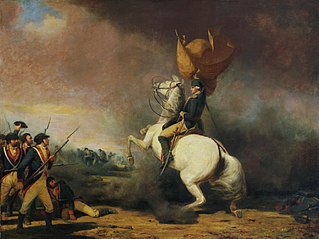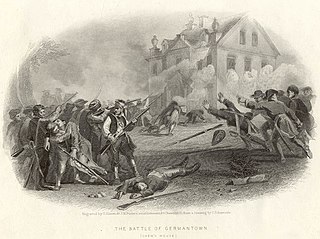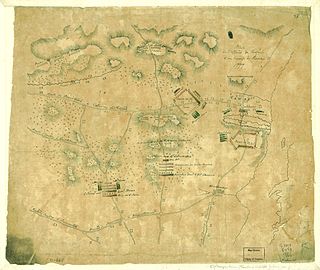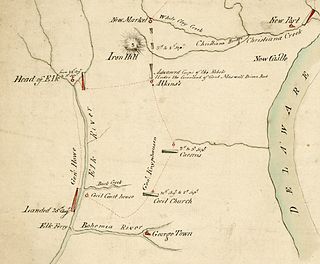
The Battle of Brandywine, also known as the Battle of Brandywine Creek, was fought between the American Continental Army of General George Washington and the British Army of General Sir William Howe on September 11, 1777, as part of the American Revolutionary War (1775–1783). The forces met near Chadds Ford, Pennsylvania. More troops fought at Brandywine than at any other battle of the American Revolution. It was also the second longest single-day battle of the war, after the Battle of Monmouth, with continuous fighting for 11 hours.

The Battle of Princeton was a battle of the American Revolutionary War, fought near Princeton, New Jersey on January 3, 1777, and ending in a small victory for the Colonials. General Lord Cornwallis had left 1,400 British troops under the command of Lieutenant Colonel Charles Mawhood in Princeton. Following a surprise attack at Trenton early in the morning of December 26, 1776, General George Washington of the Continental Army decided to attack the British in New Jersey before entering the winter quarters. On December 30, he crossed the Delaware River back into New Jersey. His troops followed on January 3, 1777. Washington advanced to Princeton by a back road, where he pushed back a smaller British force but had to retreat before Cornwallis arrived with reinforcements. The battles of Trenton and Princeton were a boost to the morale of the patriot cause, leading many recruits to join the Continental Army in the spring.

The Battle of Germantown was a major engagement in the Philadelphia campaign of the American Revolutionary War. It was fought on October 4, 1777, at Germantown, Pennsylvania, between the British Army led by Sir William Howe, and the American Continental Army under George Washington.

Count Carl Emil Ulrich von Donop was a Hessian colonel who fought in the American Revolutionary War. He died of wounds during the Battle of Red Bank.

The New York and New Jersey campaign in 1776 and the winter months of 1777 was a series of American Revolutionary War battles for control of the Port of New York and the state of New Jersey, fought between British forces under General Sir William Howe and the Continental Army under General George Washington. Howe was successful in driving Washington out of New York, but overextended his reach into New Jersey, and ended the New York and New Jersey campaign in January 1777 with only a few outposts near New York City under British control. The British held New York Harbor for the rest of the Revolutionary War, using it as a base for expeditions against other targets.

George Washington's crossing of the Delaware River, which occurred on the night of December 25–26, 1776 during the American Revolutionary War, was the first move in a complex and surprise military maneuver and attack organized by George Washington, the commander-in-chief of the Continental Army, which culminated in their attack on Hessian forces garrisoned at Trenton. The Hessians were German mercenaries hired by the British.

The Battle of the Assunpink Creek, also known as the Second Battle of Trenton, was a battle between American and British troops that took place in and around Trenton, New Jersey, on January 2, 1777, during the American Revolutionary War, and resulted in an American victory.

The Battle of Bound Brook was a surprise attack conducted by British and Hessian forces against a Continental Army outpost at Bound Brook, New Jersey during the American Revolutionary War. The British objective of capturing the entire garrison was not met, although prisoners were taken. The U.S. commander, Major General Benjamin Lincoln, left in great haste, abandoning papers and personal effects.
The history of Delaware as a political entity dates back to the early colonization of North America by European settlers. Delaware is made up of three counties established in 1638, before the time of William Penn. Each county had its own settlement history. The state's early colonists tended to identify more closely with their county than Delaware as a whole. Large parts of southern and western Delaware were thought to have been in Maryland until 1767. The state has existed in the wide economic and political circle of the nearby Pennsylvanian city of Philadelphia.

New Jersey played a central role in the American Revolution both politically and militarily. It was the site of more than 90 military engagements, including the pivotal battles of Trenton, Princeton, and Monmouth. George Washington led his army across the state four times and encamped there during three hard winters, enduring some of the greatest's setbacks of the war as well as seminal victories. New Jersey's decisive role in the conflict earned it the title, "Crossroads of the American Revolution".
The Battle of Gloucester was a skirmish fought between November 25, 1777 and the early morning of November 26, 1777, during the Philadelphia campaign of the American Revolutionary War. It was the first battlefield command for the Marquis de Lafayette.

The Battle of White Marsh or Battle of Edge Hill was a battle of the Philadelphia campaign of the American Revolutionary War fought December 5–8, 1777, in the area surrounding Whitemarsh Township, Pennsylvania. The battle, which took the form of a series of skirmish actions, was the last major engagement of 1777 between British and American forces.
The Battle of Matson's Ford was a battle in the Philadelphia campaign of the American Revolutionary War fought on December 11, 1777 in the area surrounding Matson's Ford. In this series of minor skirmish actions, advance patrols of Pennsylvania militia encountered a British foraging expedition and were overrun. The British pushed ahead to Matson's Ford, where units of the Continental Army were making their way across the Schuylkill River. The Americans retreated to the far side, destroying their temporary bridge across the Schuylkill. The British left the area the next day to continue foraging elsewhere; the Continentals crossed the river at Swede's Ford to Bridgeport, Pennsylvania, a few miles upriver from Matson's Ford.

The Battle of Red Bank, also known as the Battle of Fort Mercer, was fought on October 22, 1777, during the American Revolutionary War. A British and Hessian force was sent to take Fort Mercer on the New Jersey side of the Delaware River just south of Philadelphia, but was defeated by a smaller force of Continental Army troops.
The Brandywine Battlefield Historic Site is a National Historical Landmark. The historic park is owned and operated by the Pennsylvania Historical and Museum Commission, on 52 acres (210,000 m2), near Chadds Ford, Delaware County, Pennsylvania in the United States.

The Battle of the Short Hills was a conflict between a Continental Army force commanded by Brigadier General William Alexander, and an opposing British force commanded by Lieutenant General William Howe. The battle took place on June 26, 1777, at Scotch Plains and Edison, New Jersey, during the American Revolutionary War.

Fort Mercer was an earthen fort on the eastern shores of the Delaware River in New Jersey that was constructed by the Continental Army during the American Revolutionary War. The fort was built in 1777 by Polish engineer Thaddeus Kosciuszko under the command of George Washington. Along with Fort Mifflin on the Pennsylvania side of the Delaware River to its west, Fort Mercer was designed to block the British advance on the revolutionary capital of Philadelphia during the Philadelphia campaign.

The Battle of Cooch's Bridge, also known as the Battle of Iron Hill, was fought on September 3, 1777, between the Continental Army and American militia and primarily German soldiers serving alongside the British Army during the American Revolutionary War. It was the only significant military action during the war on the soil of Delaware, and it took place about a week before the major Battle of Brandywine. Some traditions claim this as the first battle which saw the U.S. flag.

Trimbleville, Pennsylvania, also known as Trimble's Ford and the Trimbleville Historic District is a hamlet of roughly six homes that is located in southern Chester County, Pennsylvania, approximately two miles south of Marshallton.
The "German Battalion" was an infantry formation of the Continental Army during the American Revolutionary War. Authorized in May 1776 as an extra Continental regiment, the battalion recruited ethnic Germans from Maryland and Pennsylvania.

















